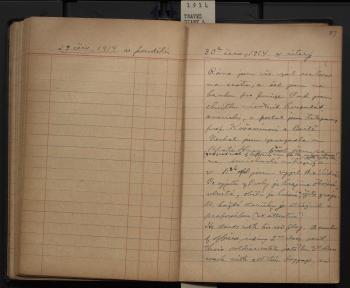As we digitize the Archives’ collections to make them available online, I am constantly being exposed to handwriting from the past two centuries. As a result, I have a deeper appreciatiation of how many different things influence the way a person’s writing appears on the page, things beyond the quality of their penmanship. Writing on the deck of a ship, on horseback or on their knee by a campfire is more challenging than doing so at a well-lit desk. So is writing in a small pocket notebook versus on normal stationery, and for another, writing in a language that person learned later in life. All of these things factor into the legibility of the hand-written collections materials, and demands of the reader, cursive literacy if we are understand and value them for the treasures they are.
In the United States, cursive handwriting seemed to fall out of our school curricula years ago. The Common Core curriculum adopted by all but eight states requires students to learn to “use technology to produce and publish writing (using keyboarding skills)” as early as third grade. Some thought this would result in a handwriting illiteracy and negatively effect people’s ability to interpret cultural resources from personal diairies to manuscripts and historical works.

How, then, do our current and future scholars make sense of the wealth of handwritten primary source materials from the early modern and modern eras? Paleography to the rescue? I think so, at least in part.
Paleography is the study of historical handwriting and includes skills of deciphering, reading and dating texts and understanding the cultural context within which a work was produced. The image that comes to mind when I think of a a paleographer is someone poring over a scroll written in the Middle Ages. Despite being cursive literate, I’ve spent hours trying to make heads and tails of handwriting in a journal from the mid-1840’s, so I thought perhaps some paleography tips might help. An online search yielded some free online tutorials, like the UK National Archives tutorial for English scripts from the 1500’s to the 1800’s, and another tool for Spanish paleography from the CUNY Dominican Studies Institute.
 Investing just a little time in an online paleography tutorial, I noticed an improvement in my recognition of different spelling patterns and writing conventions as I worked on projects in the Smithsonian Transcription Center. I found the tutorials useful as a primers on methodology, techniques, and tips which apply to challenging handwriting from the modern era as well as far older texts. In the face of handwriting illiteracy, paleography tools may help us grasp how important access to our historical record truly is.
Investing just a little time in an online paleography tutorial, I noticed an improvement in my recognition of different spelling patterns and writing conventions as I worked on projects in the Smithsonian Transcription Center. I found the tutorials useful as a primers on methodology, techniques, and tips which apply to challenging handwriting from the modern era as well as far older texts. In the face of handwriting illiteracy, paleography tools may help us grasp how important access to our historical record truly is.
Related Collections
- Columbian Institute Records, 1816-1841, with related papers, 1791-1800, Record Unit 7051, Smithsonian Institution Archives
- Arthur Wilson Stelfox Papers, 1904-1967, Record Unit 7379, Smithsonian Institution Archives
- Bohumil Shimek Papers, 1878-1936, Record Unit 7082, Shimek, Bohumil, Smithsonian Institution Archives,
Related Resources
- UK National Archives Paleography Tutorial, UK National Archives
- Spanish Paleography Tool, CUNY Domnican Studies Institute
- Smithsonian Institution Archives Transcription Projects, Smithsonian Transcription Center
- List of online resources for early modern English paleography, Folger Shakespear Library
- Cursive is making a comeback in American elementary schools, Business Insider
Produced by the Smithsonian Institution Archives. For copyright questions, please see the Terms of Use.




Leave a Comment